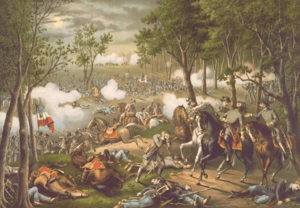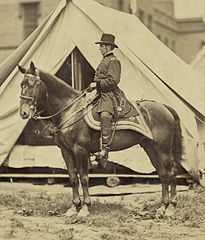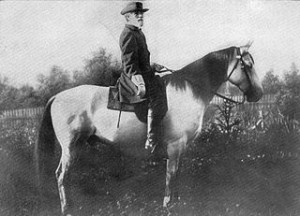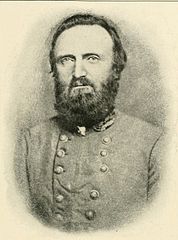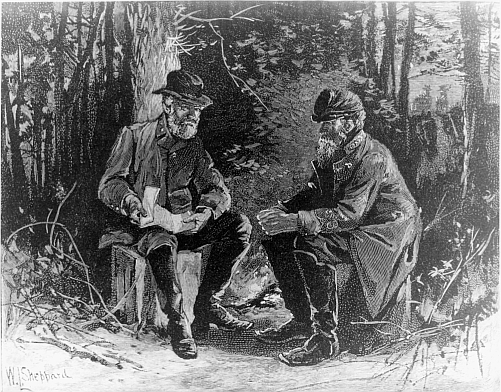Any Victory Would Be Dear At Such A Cost
May 3-6, 1863
Stonewall Jackson, shot by friendly fire from North Carolina troops the night of May 2, has his mangled left arm amputated early in the morning of May 3 at a field hospital. General Robert E. Lee says of Jackson’s importance to him and the Army of Northern Virginia; “He has lost his left arm, but I have lost my right. Any victory would be dear at such a cost.”
Hazel Grove Is The Key
The best artillery officer of the Confederacy, Colonel Edward Porter Alexander, reports to General James Ewell Brown “Jeb” Stuart early the morning of May 3 that a high piece of ground called Hazel Grove would be the perfect point to stage an artillery attack. Stuart sends a brigade made up of Tennessee and Alabama regiments to Hazel Grove. The Confederates attack at dawn, just in time to capture four cannon and one hundred men of a Union rear guard.
Because of its very advantageous position for artillery, Hazel Grove is the key to the battlefield. If “Fighting Joe” Hooker controls Hazel Grove, he could keep the two wings of the Army of Northern Virginia separated. Hooker, with his superior number of troops, could then destroy Lee’s parted army.
Despite the great advantage of holding Hazel Grove, Hooker decides to abandon the position. Hooker chooses instead to have his troops fall back from Hazel Grove to an elevated clearing called Fairview.
Colonel Alexander quickly moves about 36 cannon into the open space of Hazel Grove and begins firing at Yankee artillery located about 1200 yards away at Fairview, and at the crossroads of Chancellorsville itself. The Confederate artillery is triumphant. It was recently reorganized into a battalion system, allowing it to have an ample amount of guns in large, mobile groups. This organization of the Confederate artillery made it much more efficient and effective.
The advantageous high ground of Hazel Grove and the battalion system of artillery management led Douglas Southall Freeman (the Army of Northern Virginia’s leading historian) to comment: “At Hazel Grove the finest artillerists of the Army of Northern Virginia were having their greatest day.” With the artillery support, the Confederate infantry stages a full attack on the Federal lines.
A Dazed And Groggy “Fighting Joe”
General “Fighting Joe” Hooker experiences personally some of the Confederate artillery. Hooker is at his Chancellorsville house headquarters leaning against a white porch column on the second-story veranda. A Confederate shell hits the porch column but does not explode. Hooker is knocked unconscious and suffers a concussion, but the dazed and groggy “Fighting Joe” continues in command.Some of Hooker’s officers wish Hooker would start a counterattack in response to the Confederate offensive. These officers are disappointed when Hooker instead chooses to retreat one or two miles towards the north into a defensive line.
Robert E. Lee’s Gamble Pays Off
The two wings of Lee’s army reunite and Lee’s great gamble at Chancellorsville pays off. The Confederates push the Yankees back to the Chancellorsville crossroads intersection. General Lee rides his horse Traveller onto the battle scene, the sight of Lee with Traveller charges the enthusiasm of the Confederates and they cheer their general. Lee is in triumph and his men are celebrating, but a crisis soon comes.
Word comes from Fredericksburg that Lee’s rear guard is in trouble. General Jubal Early leads the rear guard and his 11,000 men are up against twice as many Union soldiers led by General John Sedgwick. On the morning of May 3, Confederate Colonel Thomas M. Griffen accepts (against regulations) a flag of truce. During the truce, the Federals see that they outnumber their enemy. The Federals advance upon the Confederates, moving over ground where so much loss and grief had occurred for them the previous December during the Battle of Fredericksburg. They cross the plain below Marye’s Heights, and move over the stone wall and Sunken Road, giving Sedgwick’s troops a path to the rear of General Lee’s position.
Sedgwick’s advance ends at Salem Church, about four miles west of Marye’s Heights. Five brigades of Alabama troops (all tough and veteran fighters) led by Marcellus Wilcox, use Salem Church for protection as they make a stand. Lee sends General Lafayette McLaws and his troops to Salem Church for reinforcement of Wilcox and his Alabamians. Later, Lee himself arrives. The fighting tapers off late in the day on May 3. On May 4, the Confederates push Sedgwick back to the Rappahannock River. The Union soldiers retreat across the Rappahannock on the night of May 4-5.With Sedgwick now across the Rappahannock River, Lee returns to Chancellorsville on May 5 and begins planning a new offensive against Hooker’s men. Nevertheless, a new Confederate offensive proves unnecessary. On the morning of May 6, Lee learns from scouts that under the cover of night, the Yankees have retreated north of the Rappahannock River.
My God! My God! What Will The Country Say?
President Lincoln has been monitoring the Chancellorsville battle from the telegraph office in the War Department. During the battle, Lincoln hears reports that are often contradictory or incomplete. On May 6 however, Lincoln learns the certain results of Chancellorsville. He is not pleased. A newspaperman wrote Lincoln’s face turned “ashen” upon hearing the bad news of Chancellorsville. The president exclaims: “My God! My God! What will the country say?”
The country’s reaction to the Union defeat at Chancellorsville is not good. With the Union’s defeat at Fredericksburg, and now a loss at Chancellorsville, the country has been hearing too much bad news too often. Things are looking bad for the Union.
Lee’s Masterpiece
For General Robert E. Lee and the Confederacy, things are looking good. Lee has won a great battle at Chancellorsville, it his masterpiece.
Stonewall Jackson Is Recovering
Meanwhile, twenty-five miles southeast of Chancellorsville in a house at Guinea Station, General Thomas Jonathan “Stonewall” Jackson is healing from his wounds and amputation.The news from Guinea Station is good too for General Lee and the South: Thomas Jonathan “Stonewall” Jackson is recovering.
NEXT: Stonewall Jackson’s recovery…
PREVIOUS: Chancellorsville May 2, 1863
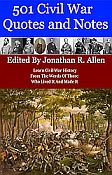 My book 501 Civil War Quotes and Notes features quotes made before, during, and after the Civil War. Each quote has an informative note to explain the circumstances and background of the quote. Learn Civil War history from the spoken words and writings of the military commanders, political leaders, the Billy Yanks and Johnny Rebs who fought in the battles, the abolitionists who strove for the freedom of the slaves, the descriptions of battles, and the citizens who suffered at home. Their voices tell us the who, what, where, when, and why of the Civil War. Available as a Kindle device e-book or as a paperback. Get 501 Civil War Quotes and Notes now!
My book 501 Civil War Quotes and Notes features quotes made before, during, and after the Civil War. Each quote has an informative note to explain the circumstances and background of the quote. Learn Civil War history from the spoken words and writings of the military commanders, political leaders, the Billy Yanks and Johnny Rebs who fought in the battles, the abolitionists who strove for the freedom of the slaves, the descriptions of battles, and the citizens who suffered at home. Their voices tell us the who, what, where, when, and why of the Civil War. Available as a Kindle device e-book or as a paperback. Get 501 Civil War Quotes and Notes now!
